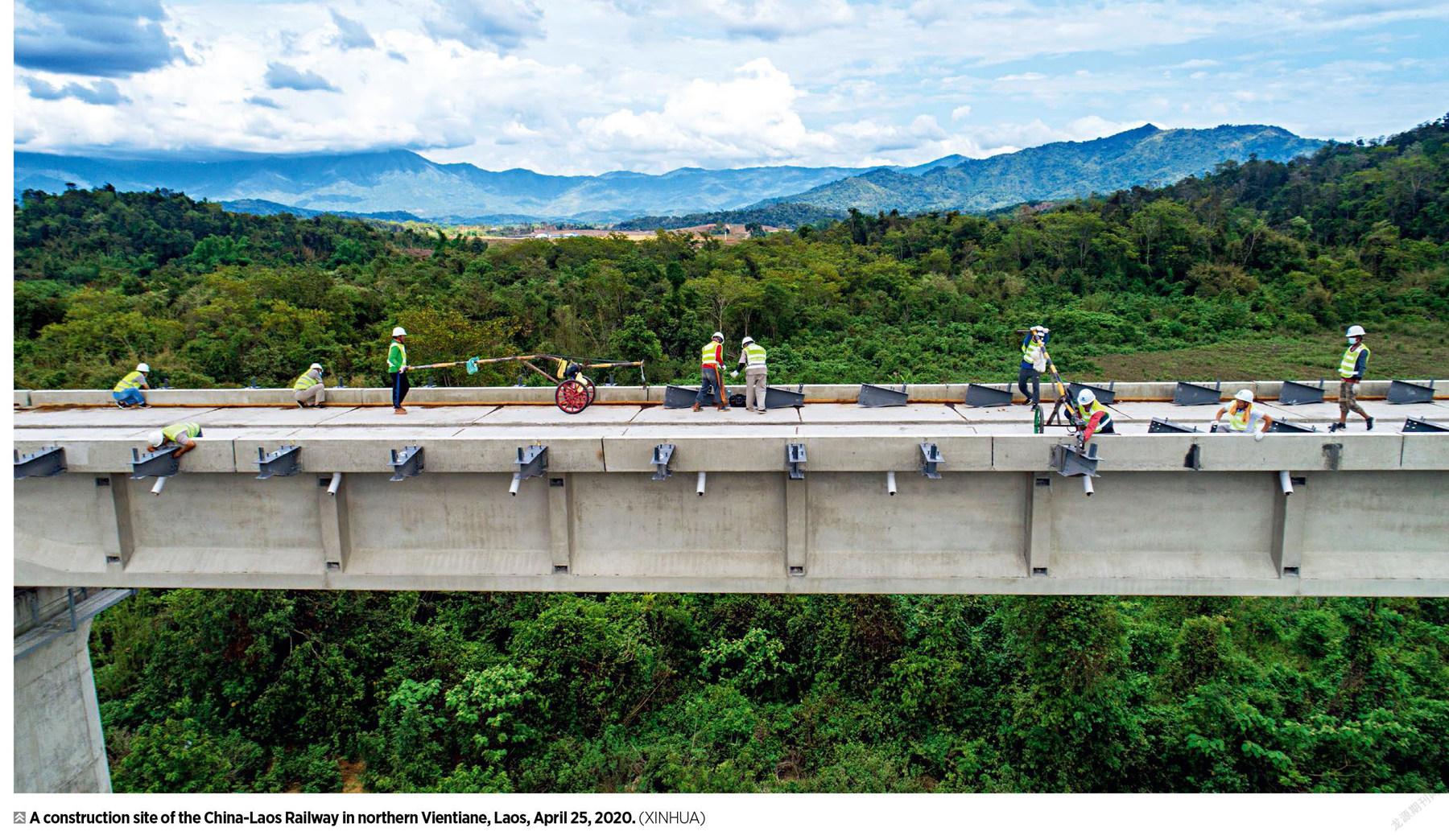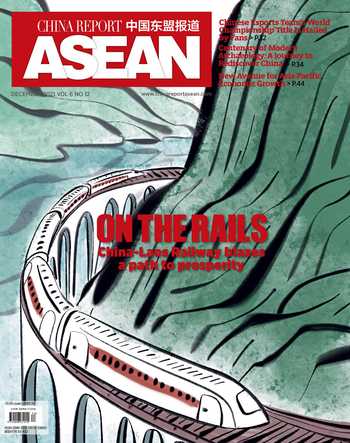A SUBTLE ECOLOGICAL CORRIDOR

In order to bypass nature reserves,bridge and tunnel ratio is quitehigh along the China-Laos Railway,suggesting great difficulty inconstruction. To ensure traffic is not affected during project construction, builders rebuilt and expandedexisting roads as constructionaccess paths. Water for construction purposes needed to pass three layers of precipitation and could only bedischarged after testing reached certain standards…. As a main contractor ofthe China-Laos Railway, China Railway Group Ltd.(CREC) had to navigatetricky terrain, weather, climate, andother challenges while committedto achieving the highest standards ofeco-environment protection duringconstruction.
In terms of ecological environment, the China-Laos Railway is the firstcross-border railway in the worldto carry out systematic greeningand landscape design for the entireline, and the first trunk railwayproject in Asia to integrate ecologicalenvironmental protection, landscapebeautification, and cultural customs. While laying rails, builders designed an international landscape and culturalcorridor along the Belt and Road thathas become a model for regionalconnectivity.
Elephants and Railway
Known as a“Museum of ForestEcology,”Xishuangbanna DaiAutonomous Prefecture at thesouthwestern tip of Yunnan Province is home to the worlds only tropicalrainforest along the Tropic of Cancer.It protects 756 species of wild animals, a quarter of the total in China. Some 109 species of rare animals found here are listed under Chinas national key protection. The tropical rainforest also hosts elephants, the largest animals on land. It is inhabited by the largest population of wild Asian elephants in China merely over 300.
China Railway No. 3 Engineering Group Co., Ltd. built Section 16 of the Yuxi-Mohan section of ChinaLaos Railway located in Jinghong City of Xishuangbanna. Yexiang (Wild Elephant) Valley Station, the landmark of the project, was so-named because the station is adjacent to Wild ElephantValley in Xishuangbanna National Nature Reserve. Mengyang Tunnel, the longest tunnel of the Section 16 project, passes under Wild Elephant Valley.
To minimize interference with the original ecological environment and maintain the “authentic and original appearance” of Wild Elephant Valley as much as possible, the project department integrated environmental protection into the entire process of construction from the start. By using an advanced treatment system to separate waste water and waste residue, the removed sand and gravel were repurposed for temporary construction projects. The treatedwaste residue was pressed into mudcakes that could be directly used formaintenance of construction detours. The sewage, treated by filter press,became clean and flew into a tankfor recycling. The equipment savedmore than 100 tons of flushed waterper day. All kinds of waste water andwaste materials were fully utilized,which effectively reduced the impacton the living environment of localanimals and plants, especially Asianelephant communities. While optingto“make way for elephants,”thebuilders also chose to implementa green construction concept withpractical action to build an ecologicalenvironment in which man and nature coexist in harmony.
To protect rare Asian elephants in the Xishuangbanna NationalNature Reserve while building the Yuxi-Mohan section, China Railway Eryuan Engineering Group Co., Ltd. (CREEC) carefully compared four plans: a full tunnel plan, a full bridge plan, bypassing the nature reserve from both sides, and solutions for building bridges in partial areas. Geological factors made it difficult to avoid the habitat of Asian elephants. About 14 kilometers from the experimental area of the Xishuangbanna National Nature Reserve, CREEC extended the tunnel to reduce surface exposure, adjusted the position of the inclined shaft of the tunnel, and replaced roads with bridges to avoid the main habitats of Asian elephants and minimize the impact of the project on the migration routes of Asian elephants.
To protect the activity habits of Asian elephants, CREEC innovatively developed steel wire grille protective fences after repeated experimentation. Concerned about the possibility of elephants straying into the railway area, protective fences were erected at the entrances and exits of the tunnels and the junctions of roads and bridges near the nature reserve. CREEC also optimized construction organization, avoided temporary projects in the nature reserve, strengthened management during the construction period, minimized the impact of project construction and operation on Asian elephants, and effectively formed a railway environmental protection assessment system that features “careful planning, optimized engineering, effective protective measures, and strict management” in ecologically sensitive areas.
Ecological Corridor
Before any designs were drawn, CREEC had already set the goal of making the China-Laos Railway a demonstration project of a green landscape corridor. The China-Laos Railway was the first cross-border railway in the world to carry out systematic greening and landscape design throughout the line and the first trunk railway project in Asia to integrate ecological environmental protection, landscape beautification, and cultural customs. While laying the railway, the builders constructed an international landscape and cultural corridor along the Belt and Road as a model of regional connectivity. Efforts were made to reduce human intervention in ecosystems and allow nature to exert more control. The “sponge city” concept was applied to the design of the station square and production and living areas to realize collection and utilization of natural rainfall. Considering the harsh environments such as strong sunshine and alternating heavy rain and drought along the line, the designers optimized the plant types and layout patterns and improved embankment slope green protection, in an effort to achieve greenery throughout the year with flowers blooming in three seasonsPlacing a heavy emphasis on environmental protection in the construction of the ChinaLaos Railway, CREC incorporated environmental protection measures into the construction planning while enhancing on-site management. To dispose of soil and rocks from tunnel construction, units established soil dumping sites, built retaining walls, and planted trees and grass after completion to prevent soil erosion and make the Belt and Road truly a green road. When choosing construction detours, units decided to widen and harden the existing rural roads to not only meet the needs of project construction, but also facilitate travel for locals and beautify surrounding villages. These efforts reduced the damage of new roads to local ecological environment, thus minimizing the impact of railway construction on the environment.
CREC workers participating in the cross-border railway construction have proved the philosophy of “treating the ecological environment like life” with practical actions, making the railway a strategic road, a scientific and technological channel, and a beautiful ecological corridor.

